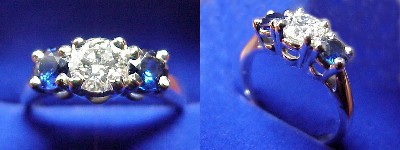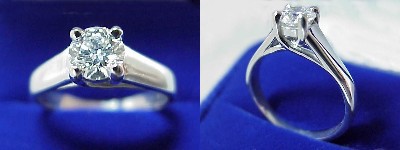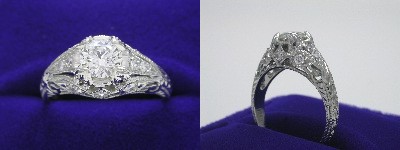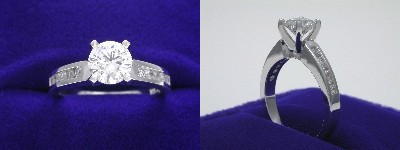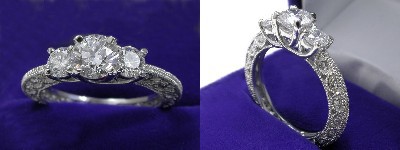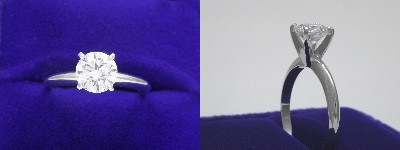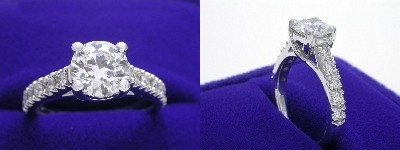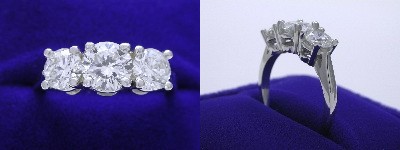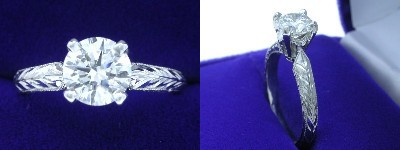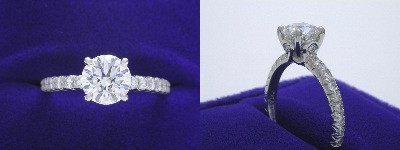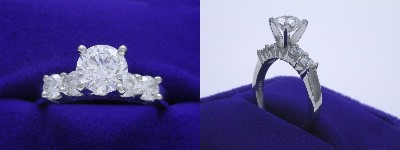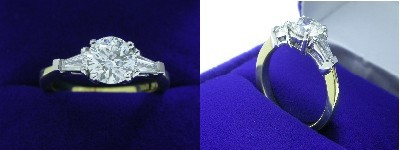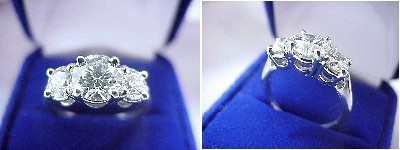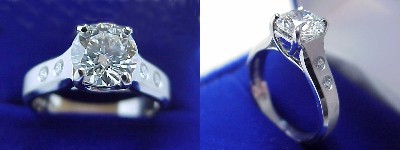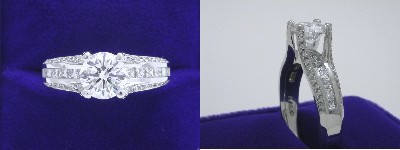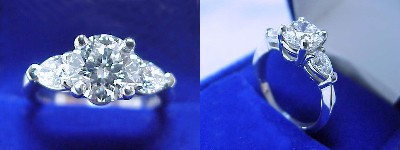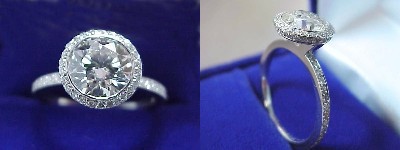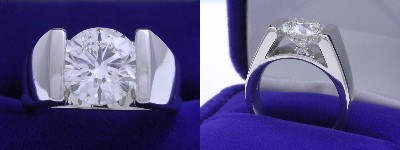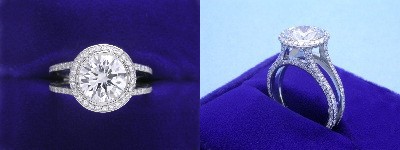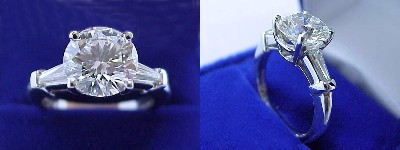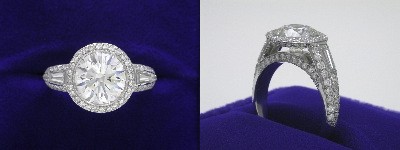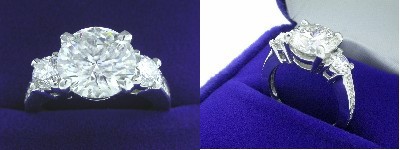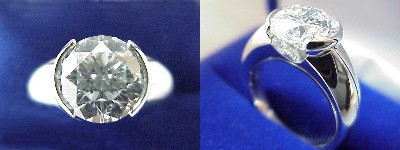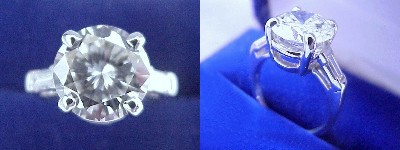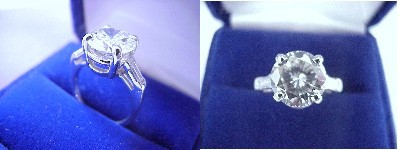The round brilliant diamond is the most popular diamond shape and, because of the laws of supply and demand, is the generally the most expensive.
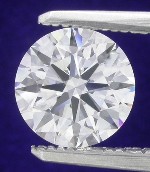 Round brilliants make up the vast majority of diamonds found in engagement rings. Round brilliant diamonds are also popular as stud earrings and in pendants. This shape has set the standard for all other diamond shapes, and accounts for more than 75% of diamonds sold today.
Round brilliants make up the vast majority of diamonds found in engagement rings. Round brilliant diamonds are also popular as stud earrings and in pendants. This shape has set the standard for all other diamond shapes, and accounts for more than 75% of diamonds sold today.
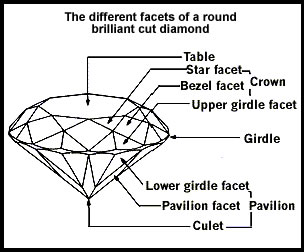 There are 58 facets in a Round Brilliant Cut including the culet. On the Crown or upper part of the Diamond, these consist of 1 table facet, 8 bezel facets, 8 star facets, and 16 upper girdle facets for a total of 33. On the pavilion, or bottom part of the Diamond, there are 16 lower girdle facets, 8 pavilion main facets and 1 culet. If the pavilion comes to a point at the bottom, the diamond does not have a culet.
There are 58 facets in a Round Brilliant Cut including the culet. On the Crown or upper part of the Diamond, these consist of 1 table facet, 8 bezel facets, 8 star facets, and 16 upper girdle facets for a total of 33. On the pavilion, or bottom part of the Diamond, there are 16 lower girdle facets, 8 pavilion main facets and 1 culet. If the pavilion comes to a point at the bottom, the diamond does not have a culet.
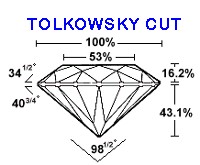 The early modern Tolkowsky brilliant cut emerged with Marcel Tolkowsky’s published thesis entitled, “Diamond Design: A Study of the Reflection and Refraction of Light in Diamond”, in 1919. This was a theoretical work describing the best proportions of a round brilliant diamond which would provide a balanced return of light (brilliance) and dispersion. As a result, many cutters were led to fashion many of the larger, high quality goods in the range of these proportions. These proportions are also sometimes called the “American Ideal Cut”, even though the work originated in Europe. Subsequently, the American Gem Society adapted proportional ranges for their “Ideal” (zero, 0, best) cut grade, based on this work and they are still used today.
The early modern Tolkowsky brilliant cut emerged with Marcel Tolkowsky’s published thesis entitled, “Diamond Design: A Study of the Reflection and Refraction of Light in Diamond”, in 1919. This was a theoretical work describing the best proportions of a round brilliant diamond which would provide a balanced return of light (brilliance) and dispersion. As a result, many cutters were led to fashion many of the larger, high quality goods in the range of these proportions. These proportions are also sometimes called the “American Ideal Cut”, even though the work originated in Europe. Subsequently, the American Gem Society adapted proportional ranges for their “Ideal” (zero, 0, best) cut grade, based on this work and they are still used today.
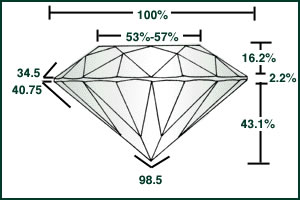 Today’s modern round brilliant cut diamond, produced largely since World War II, differs in several ways from the Tolkowsky cut. The Tolkowsky brilliant had a larger culet, visible through the table, whereas today’s round brilliant has either no culet, or a very small or small culet. Also, the table size range is larger in today’s round cuts (about 53-57%, as a percent of the stone’s average diameter), but still include Tolkowsky’s calculations which called for a 53% table. Finally, the lower girdle facets are now cut much deeper (about 75%) down the pavilion compared to earlier patterns, where they were cut to only about 1/3 of the pavilion depth.
Today’s modern round brilliant cut diamond, produced largely since World War II, differs in several ways from the Tolkowsky cut. The Tolkowsky brilliant had a larger culet, visible through the table, whereas today’s round brilliant has either no culet, or a very small or small culet. Also, the table size range is larger in today’s round cuts (about 53-57%, as a percent of the stone’s average diameter), but still include Tolkowsky’s calculations which called for a 53% table. Finally, the lower girdle facets are now cut much deeper (about 75%) down the pavilion compared to earlier patterns, where they were cut to only about 1/3 of the pavilion depth.
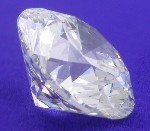 The rounds brilliant is the most popular of the diamond shapes. It is also the most brilliant of all the cuts. You may have heard of a term called “Ideal Cut”. This term refers to the attempt to cut a round diamond into the best proportions to achieve maximum brilliance. Today’s modern round brilliant diamond is precisely cut to maximize the diamond’s brilliance, fire and size.
The rounds brilliant is the most popular of the diamond shapes. It is also the most brilliant of all the cuts. You may have heard of a term called “Ideal Cut”. This term refers to the attempt to cut a round diamond into the best proportions to achieve maximum brilliance. Today’s modern round brilliant diamond is precisely cut to maximize the diamond’s brilliance, fire and size.
For a detailed information on what constitutes great cut in a round brilliant diamond, check out the discussion on cut in our diamond education section.
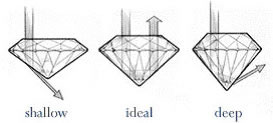 If diamond cutters know how to optimize the cut, why don’t they cut every round diamond to ideal proportions? The answer is that usually a cutter is trying to maximize the weight of the diamond cut from the rough crystal which is not necessarily the same as the ideal proportions. It can also take a cutter 4 to 5 times as long to cut a round brilliant diamond to ideal proportions with ideal polish and symmetry ratings than it does to cut a diamond to average cut parameters.
If diamond cutters know how to optimize the cut, why don’t they cut every round diamond to ideal proportions? The answer is that usually a cutter is trying to maximize the weight of the diamond cut from the rough crystal which is not necessarily the same as the ideal proportions. It can also take a cutter 4 to 5 times as long to cut a round brilliant diamond to ideal proportions with ideal polish and symmetry ratings than it does to cut a diamond to average cut parameters.
Rounds brilliant diamonds are the most expensive cuts, and with good reason. It is usually possible to retain more weight from a rough (unpolished) diamond if it is cut into a fancy shape than if it is cut to a round.
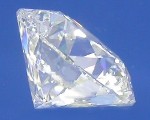 Advice: We recommend round diamonds with a depth of 59-62.5% and table of 53-59%. Symmetry is probably more important with round diamonds than with fancy shapes so we suggest at least Very Good for symmetry and Good rating for polish if possible. We recommend at least I color and SI1 clarity for round diamonds.
Advice: We recommend round diamonds with a depth of 59-62.5% and table of 53-59%. Symmetry is probably more important with round diamonds than with fancy shapes so we suggest at least Very Good for symmetry and Good rating for polish if possible. We recommend at least I color and SI1 clarity for round diamonds.
Beware of misinformation that is commonly provided by jewelry store personnel. Here are some of the Jewelry Store Tricks and Traps that pertain to round diamonds.
- A bigger table makes the diamond look bigger. The reality is that the size of the diamond is determined by the millimeter diameter of the diamond, not the size of the table facet on top. Smaller table percentages usually mean better cut.
- Diamonds with more carat weight are bigger. The reality is that round diamonds with depths over 63% are outside the ideal cut range and are going to have smaller millimeter diameter size than diamonds with lower depth percentages and the same carat weight. You want to get the biggest size with the smallest carat weight while still staying in the 59-62.5% range for depth percentage.
- Strong fluorescence will make a diamond look better. There is considerable discussion in the diamond industry as to the impact of fluorescence on a diamond.
Round brilliant diamonds are the most versatile of all the diamond shapes since they can be used in a wide variety of types of jewelry and in many styles. The brilliance and sparkle of the round brilliant diamond produce exceptional beauty.
The following photos are only a sampling of round brilliant cut diamond ring styles. Hundreds of mounting styles look great with round cut diamonds so just email us a picture of the style you like and we can get you a price quote. You can also check out our Designer Gallery for pictures of mountings from some of our suppliers.


